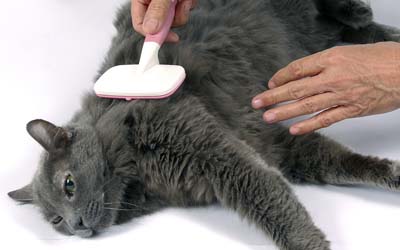
As pet owners, we like to talk about how much we hate pet hair – particularly on our clothes and in our food. But the reality is, our pets’ coats are one of the things we love about them. The great colors, various lengths, and textures from coarse to soft, all give our pets their unique look and feel.
But did you know that the health and condition of their coats is also a good indicator of our pets’ overall health? It’s true – health and nutrition affect the luster and texture of their coats from the inside, and regular brushing and skin care help keep your pet feeling good on the outside.
Regular brushing:
- Removes loose hairs and dead skin cells.
- Dramatically reduces hair and dander around the house.
- Keeps your pet from swallowing as much hair while self-grooming, reducing hairballs and digestive problems.
- Helps prevent mats and tangles that are a pain to remove.
- Removes dirt, debris and external parasites, keeping your pets clean and comfortable.
- Distributes natural oils along the hairs to keep them healthy and reduce odor.
- Lets you get to know your pet’s skin, allowing you to notice any abnormal lumps, bumps and sensitive areas early.
- Gives you quality time together – brushing is great for bonding!
As with most activities, regular brushing beginning when your pet is young will mean he or she is used to it and will most likely enjoy it. But that doesn’t mean you can’t start a brushing routine with an adult pet. Some will love it right from the start, while others will need some more training and encouragement, but with a little patience, you’ll be able to enjoy all of these benefits.
Here are five tips to help making brushing fun for you and your pet:
1. Be gentle!
Pay attention to make sure you don’t snag mats, pull hair, or get rough, because if it is an unpleasant experience for your pet, he may develop an aversion or fear of being brushed.
2. Keep it fun.
If your pet is squirming, impatient, or it is becoming an unpleasant experience, take a break – praise, play, or give a treat to keep it positive. Don’t force it – it is better to do short sessions that end well than to get it all done in one shot.
3. Keep at it.
Brushing regularly – anywhere from daily to weekly, depending on your cat or dog’s coat – helps you stay on top of it so that you never have to play catch up. This means each session will take less time, be less laborious, and be more fun.
4. Use the right tool.
- Bristle brushes are great for short-haired cats, medium-coat dogs that shed (e.g. Labrador retrievers), and pets with sensitive skin, like rabbits and guinea pigs.
- Long-toothed metal combs or brushes with offset-bristles work well for long-haired cats and dogs.
- Short bristle brushes or flexible grooming gloves work best with smooth-coated dogs like boxers and pointers.
- Slicker brushes work well for curly, non-shedding coats (e.g. poodles).
5. Know when to call a professional
Minor tangles, burrs and grass awns can be removed gently and carefully, but there are times when a mat must be cut out. If you decide to do this yourself, be very careful not to cut your pet’s skin! If the mat is really close to the skin and you aren’t absolutely sure where the skin ends and the mat begins, it’s best to seek help from a groomer or your veterinarian.
Most of all, don’t stress about it. If you find it stressful, your pet will too – but if you can relax and keep it casual, brushing can be a great way to spend some time together.
